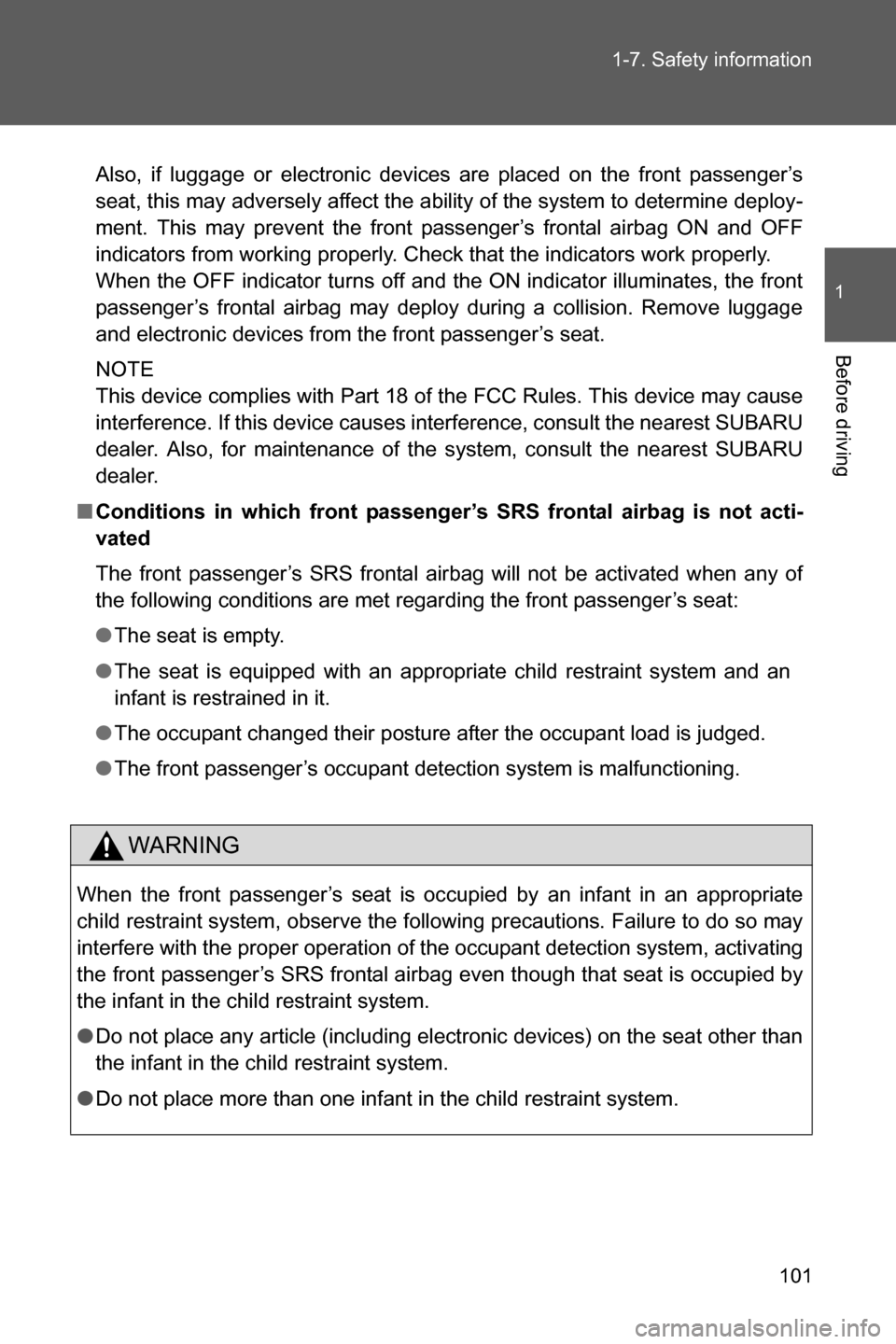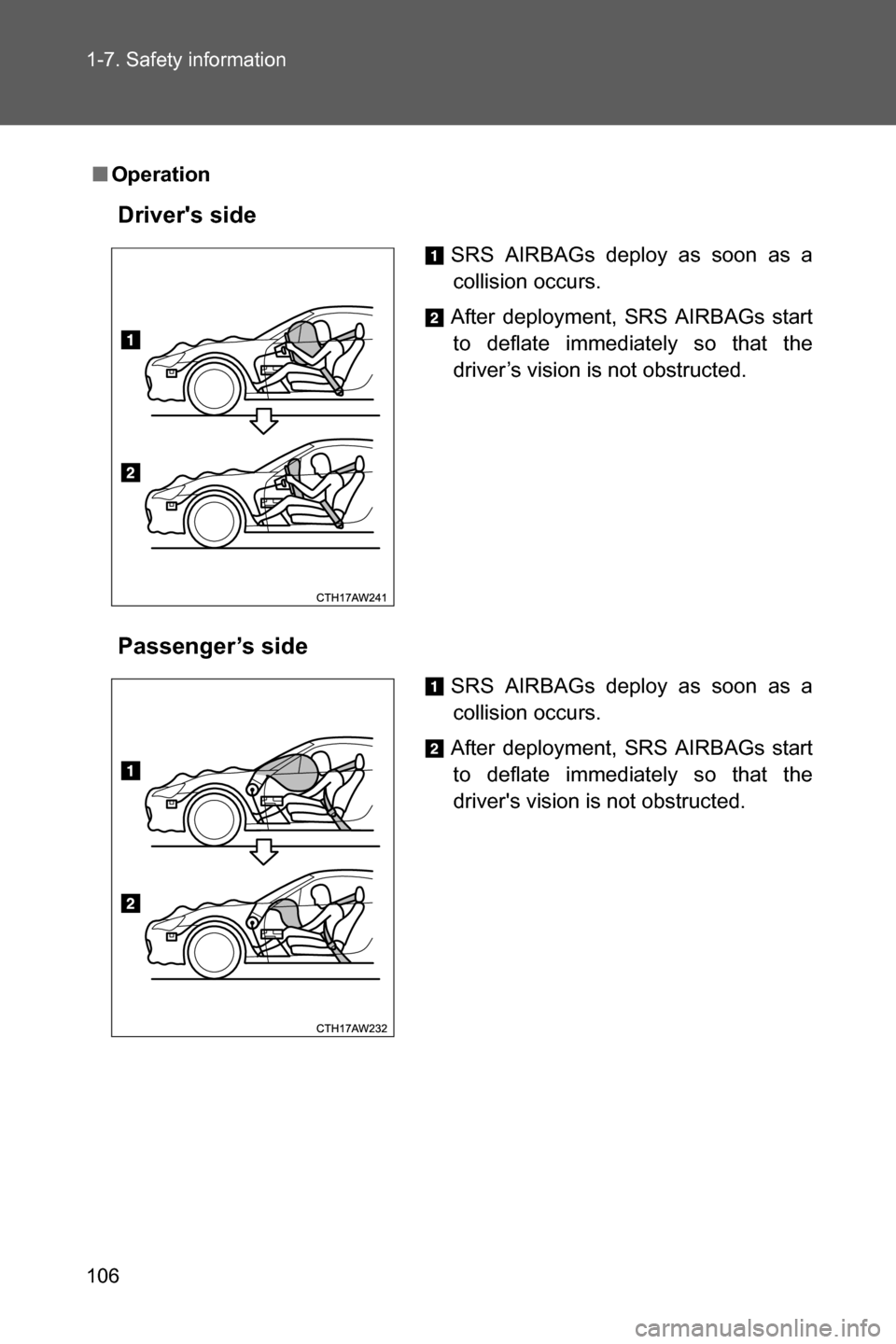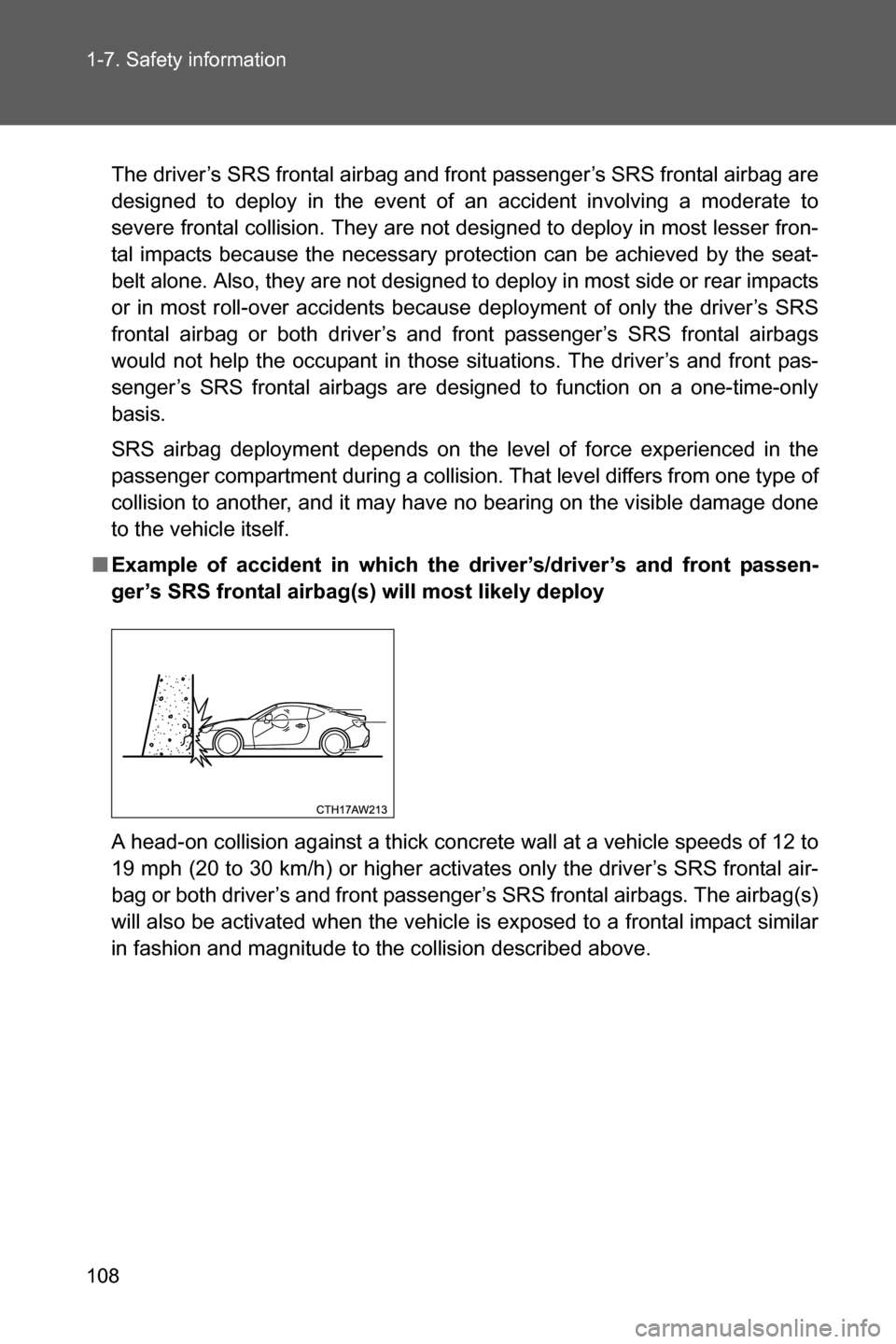SUBARU BRZ 2017 1.G Owners Manual
Manufacturer: SUBARU, Model Year: 2017, Model line: BRZ, Model: SUBARU BRZ 2017 1.GPages: 540, PDF Size: 6.88 MB
Page 101 of 540

99 1-7. Safety information
1
Before driving
■Driver’s SRS frontal airbag
The driver’s SRS frontal airbag uses a dual stage inflator. The inflator oper-
ates in different ways depending on the severity of impact.
Have the system inspected by your SUBARU dealer immediately if the SRS
airbag system warning light illuminates.
NOTE
The driver’s SRS side airbag and SRS curtain airbag are not controlled by
the SUBARU advanced frontal airbag system.
■Front passenger’s SRS frontal airbag
The front passenger’s SRS frontal airbag uses a dual stage inflator. The
inflator operates in different ways depending on the severity of impact.
The occupant detection system sensor is installed under the seat upholstery
and monitors the physique and posture of the front passenger. Using this
information, the occupant detection system determines whether the front
passenger’s SRS frontal airbag should be deployed or not.
The occupant detection system may not inflate the front passenger’s SRS
frontal airbag even when the driver’s SRS frontal airbag deploys. This is nor-
mal. In this case, although the front passenger’s SRS frontal airbag does not
operate, the front passenger’s seatbelt pretensioner operates with the
driver’s seatbelt pretensioner. For details about the seatbelt pretensioner,
refer to “Seatbelt pretensioners”. (�oP. 61)
Observe the following precautions. Failure to do so may prevent the
SUBARU advanced frontal airbag system from functioning correctly or
cause the system to fail.
●Do not apply any strong impact to the front passenger’s seat.
●Do not spill liquid on the front passenger’s seat. If liquid is spilled, wipe it
off immediately.
●Do not remove or disassemble the front passenger’s seat.
●Do not install any accessory (such as an audio amplifier) other than a
genuine SUBARU accessory under the front passenger’s seat.
●Do not place anything (shoes, umbrella, etc.) under the front passenger’s
seat.
●Do not place a magnet near the seatbelt buckle.
Page 102 of 540

100 1-7. Safety information
If the seatbelt buckle switch and/or front passenger’s occupant detection
system have failed, the SRS airbag system warning light will illuminate.
Have the system inspected by your SUBARU dealer immediately if the SRS
airbag system warning light illuminates.
If your vehicle has sustained impact, this may affect the proper function of
the SUBARU advanced frontal airbag system. Have your vehicle inspected
at your SUBARU dealer. Do not use the front passenger’s seat while driving
the vehicle to your SUBARU dealer.
NOTE
The front passenger’s SRS side airbag and SRS curtain airbag are not con-
trolled by the SUBARU advanced frontal airbag system.
■Passenger’s frontal airbag ON and OFF indicators
�oP. 129
■Occupant detection system
The occupant detection system sensor is installed under the seat upholstery
and monitors the physique and posture of the front passenger. Using this
information, the occupant detection system determines whether the front
passenger’s SRS frontal airbag should be deployed or not.
If the front passenger’s seat cushion is wet, this may adversely affect the
ability of the system to determine deployment. If the seat cushion is wet, the
front passenger should stop sitting on the front passenger’s seat. Wipe off
liquid from the seat immediately, let the seat dry naturally and then check the
SRS airbag system warning light as follows.
●If the SRS airbag system warning light illuminates, keep the seat dry until
the warning light turns off. If the SRS airbag system warning light stays
on even when the seat has dried, do not allow anyone to sit on the front
passenger’s seat and have the system checked by your SUBARU dealer.
●If the SRS airbag system warning light does not illuminate, check that the
front passenger’s frontal airbag ON and OFF indicators work properly. If
the indicators do not work properly, do not allow anyone to sit on the front
passenger’s seat and have the system checked by your SUBARU dealer.
Page 103 of 540

101 1-7. Safety information
1
Before driving
Also, if luggage or electronic devices are placed on the front passenger’s
seat, this may adversely affect the ability of the system to determine deploy-
ment. This may prevent the front passenger’s frontal airbag ON and OFF
indicators from working properly. Check that the indicators work properly.
When the OFF indicator turns off and the ON indicator illuminates, the front
passenger’s frontal airbag may deploy during a collision. Remove luggage
and electronic devices from the front passenger’s seat.
NOTE
This device complies with Part 18 of the FCC Rules. This device may cause
interference. If this device causes interference, consult the nearest SUBARU
dealer. Also, for maintenance of the system, consult the nearest SUBARU
dealer.
■Conditions in which front passenger’s SRS frontal airbag is not acti-
vated
The front passenger’s SRS frontal airbag will not be activated when any of
the following conditions are met regarding the front passenger’s seat:
●The seat is empty.
●The seat is equipped with an appropriate child restraint system and an
infant is restrained in it.
●The occupant changed their posture after the occupant load is judged.
●The front passenger’s occupant detection system is malfunctioning.
WARNING
When the front passenger’s seat is occupied by an infant in an appropriate
child restraint system, observe the following precautions. Failure to do so may
interfere with the proper operation of the occupant detection system, activating
the front passenger’s SRS frontal airbag even though that seat is occupied by
the infant in the child restraint system.
●Do not place any article (including electronic devices) on the seat other than
the infant in the child restraint system.
●Do not place more than one infant in the child restraint system.
Page 104 of 540

102 1-7. Safety information
■If the front passenger’s frontal airbag ON indicator illuminates and the
OFF indicator turns off even when an infant or a small child is in a child
restraint system (including booster seat)
Turn the ignition switch to the “LOCK” position (vehicles without a keyless
access with push button start system), or turn the push-button ignition switch
off (vehicles with a keyless access with push button start system) if the front
passenger’s frontal airbag ON indicator illuminates and the OFF indicator
turns off even when an infant or a small child is in a child restraint system
(including booster seat). Remove the child restraint system from the seat. By
referring to the child restraint manufacturer’s recommendations as well as
the child restraint system installation procedures in “Child restraint systems”
(�oP. 139), correctly install the child restraint system. Turn the ignition switch
to the “ON” position (vehicles without a keyless access with push button start
system), or turn the push-button ignition switch to the “ON” mode (vehicles
with a keyless access with push button start system) and make sure that the
front passenger’s frontal airbag ON indicator turns off and the OFF indicator
illuminates.
If still the ON indicator remains illuminated while the OFF indicator turns off,
take the following actions.
●Ensure that no article is placed on the seat other than the child restraint
system and the child occupant.
●Ensure that the backward-forward position and seatback of front passen-
ger’s seat are locked into place securely by moving the seat back and
forth.
If the ON indicator still remains illuminated while the OFF indicator turns off
after taking relevant corrective actions described above, relocate the child
restraint system to the rear seat and immediately contact your SUBARU
dealer for an inspection.
NOTE
When a child who has outgrown a child restraint system or a small adult is
seated in the front passenger’s seat, the SUBARU advanced frontal airbag
system may or may not activate the front passenger’s SRS frontal airbag
depending on the occupant’s seating posture. The child should always wear
the seatbelt when sitting in the seat irrespective of whether the airbag is
deactivated or activated. If the front passenger’s SRS frontal airbag is acti-
vated (the ON indicator remains illuminated while the OFF indicator turns
off), take the following actions.
Page 105 of 540

103 1-7. Safety information
1
Before driving
●Ensure that no article is placed on the seat other than the occupant.
If the ON indicator still remains illuminated while the OFF indicator turns off
despite the fact that the actions noted above have been taken, seat the
child/small adult in the rear seat and immediately contact your SUBARU
dealer for an inspection. Even if the system has passed the dealer inspec-
tion, it is recommended that on subsequent trips the child/small adult always
take the rear seat.
Children who have outgrown a child restraint system should always wear the
seatbelt irrespective of whether the airbag is deactivated or activated.
■Conditions in which front passenger’s SRS frontal airbag is activated
The front passenger’s SRS frontal airbag will be activated for deployment
upon impact when any of the following conditions are met regarding the front
passenger’s seat.
●When the seat is occupied by an adult.
●When a certain item(s) (e.g. jug of water) is placed on the seat.
Page 106 of 540

104 1-7. Safety information
■If the passenger’s frontal airbag OFF indicator illuminates and the ON
indicator turns off even when the front passenger’s seat is occupied by
an adult
This can be caused by the adult incorrectly sitting in the front passenger’s
seat. Turn the ignition switch to the “LOCK” position (vehicles without a key-
less access with push button start system), or turn the push-button ignition
switch off (vehicles with a keyless access with push button start system).
Ask the front passenger to set the seatback to the upright position, sit up
straight in the center of the seat cushion, correctly fasten the seatbelt, posi-
tion his/her legs out forward, and adjust the seat to the rearmost position.
Turn the ignition switch to the “ON” position (vehicles without a keyless
access with push button start system), or turn the push-button ignition switch
to the “ON” mode (vehicles with a keyless access with push button start sys-
tem). If the OFF indicator remains illuminated while the ON indicator remains
off, take the following actions.
●Vehicles without a keyless access with push button start system:
Turn the ignition switch to the “LOCK” position.
Vehicles with a keyless access with push button start system:
Turn the push-button ignition switch off.
●Make sure that the front passenger does not use a blanket, seat cushion,
seat cover, seat heater or massager, etc.
●If wearing excessive layers of clothing, the front passenger should
remove any unnecessary items before sitting in the front passenger’s
seat, or should sit in a rear seat.
●Next, turn the ignition switch to the “ON” position and wait 6 seconds to
allow the system to complete self-checking. Following the system check,
both indicators turn off for 2 seconds. Now, the ON indicator should illu-
minate while the OFF indicator remains off.
If the OFF indicator still remains illuminated while the ON indicator remains
off, ask the occupant to move to the rear seat and immediately contact your
SUBARU dealer for an inspection.
Page 107 of 540

105 1-7. Safety information
1
Before driving
■How to contact the vehicle manufacturer concerning modifications for
persons with disabilities that may affect the advanced airbag system
Changing or moving any parts of the front seats, rear seat, seatbelts, front
bumper, front side frame, radiator panel, instrument panel, combination
meter, steering wheel, steering column, tire, suspension or floor panel can
affect the operation of the SUBARU advanced airbag system. If you have
any questions, you may contact the following SUBARU distributors.
Subaru of America, Inc.
Customer Dealer Services Department
P.O. Box 6000
Cherry Hill, NJ 08034-6000
1-800-SUBARU3 (1-800-782-2783)
Subaru Hawaii
2850 Pukoloa Street, Suite 202, Honolulu,
HI 96819-4467
808-839-2273
Shen’s Corporation dba Prestige Automobile
491, East Marine Corps Drive, Route 1 Dededo,
Guam 96921-6225
671-633-2698
Trebol Motors
P.O. Box 11204, San Juan, Puerto Rico
00910
787-793-2828
Subaru Canada, Inc.
Consumer Support Department
560 Suffolk Court, Mississauga, Ontario
L5R 4J7
1-800-894-4212
There are currently no SUBARU distributors in any other U.S. territories. If
you are in such an area, please contact the SUBARU distributor or dealer
from which you bought your vehicle.
Page 108 of 540

106 1-7. Safety information
■Operation
Driver's side
Passenger’s side
SRS AIRBAGs deploy as soon as a
collision occurs.
After deployment, SRS AIRBAGs start
to deflate immediately so that the
driver’s vision is not obstructed.
SRS AIRBAGs deploy as soon as a
collision occurs.
After deployment, SRS AIRBAGs start
to deflate immediately so that the
driver's vision is not obstructed.
Page 109 of 540

107 1-7. Safety information
1
Before driving
The SRS airbag can function only when the ignition switch is in the “ON”
position.
The SUBARU advanced frontal airbag system is designed to determine the
activation or deactivation condition of the front passenger’s SRS frontal air-
bag depending on the characteristic of the item(s) or person on the front
passenger’s seat monitored by the front passenger’s occupant detection
system sensor. For this reason, only the driver’s SRS frontal airbag may
deploy in the event of a collision, but this does not mean failure of the sys-
tem.
If the front sub sensors and the impact sensors in the airbag control module
detect a predetermined amount of force during a frontal collision, the control
module sends signals to the airbag module(s) (only driver’s module or both
driver’s and front passenger’s modules) instructing the module(s) to inflate
the SRS frontal airbag(s).
The driver’s and front passenger’s SRS frontal airbags use dual stage infla-
tors. The two inflators of each airbag are triggered either sequentially or
simultaneously, depending on the severity of impact, in the case of the
driver’s SRS frontal airbag and depending on the severity of impact and the
characteristic of the item(s) or person on the seat in the case of the front
passenger’s SRS frontal airbag.
After deployment, the SRS airbag immediately starts to deflate so that the
driver’s vision is not obstructed. The time required from detecting impact to
the deflation of the SRS airbag after deployment is shorter than the blink of
an eye.
Both when only the driver’s SRS frontal airbag deploys and the driver’s and
front passenger’s SRS frontal airbags deploy, the driver’s and front passen-
ger’s seatbelt pretensioners operate at the same time.
Although it is highly unlikely that the SRS airbag would activate in a non-
accident situation, should it occur, the SRS airbag will deflate quickly, not
obscuring vision and will not interfere with the driver's ability to maintain con-
trol of the vehicle.
When the SRS airbag deploys, a sudden, fairly loud inflation noise will be
heard and some smoke will be released. These occurrences are a normal
result of the deployment. This smoke does not indicate a fire in the vehicle.
Page 110 of 540

108 1-7. Safety information
The driver’s SRS frontal airbag and front passenger’s SRS frontal airbag are
designed to deploy in the event of an accident involving a moderate to
severe frontal collision. They are not designed to deploy in most lesser fron-
tal impacts because the necessary protection can be achieved by the seat-
belt alone. Also, they are not designed to deploy in most side or rear impacts
or in most roll-over accidents because deployment of only the driver’s SRS
frontal airbag or both driver’s and front passenger’s SRS frontal airbags
would not help the occupant in those situations. The driver’s and front pas-
senger’s SRS frontal airbags are designed to function on a one-time-only
basis.
SRS airbag deployment depends on the level of force experienced in the
passenger compartment during a collision. That level differs from one type of
collision to another, and it may have no bearing on the visible damage done
to the vehicle itself.
■Example of accident in which the driver’s/driver’s and front passen-
ger’s SRS frontal airbag(s) will most likely deploy
A head-on collision against a thick concrete wall at a vehicle speeds of 12 to
19 mph (20 to 30 km/h) or higher activates only the driver’s SRS frontal air-
bag or both driver’s and front passenger’s SRS frontal airbags. The airbag(s)
will also be activated when the vehicle is exposed to a frontal impact similar
in fashion and magnitude to the collision described above.